April 1, 2022
The Rundle Thrust Fault – Maker of Magnificent Alberta Mountains
By Dave Slaght – Travel Tales of Life
When driving through the Bow Valley corridor, between Canmore and Banff, Alberta, three stunning mountains, The Three Sisters, Mount Rundle, and Cascade Mountain, come into view. Visitors be warned that each of the trio may bring on jaw dropping and a tendency to gaze transfixed by the beauty.
Although each of these mountains possess unique characteristics, they share a common origin – the Rundle Thrust Fault.

Three mountains – One beginning
The town of Canmore nestles in the Bow Valley, a mere one-hour drive from Calgary. Once arrived, the majestic Three Sisters stand proudly with their trio of peaks profiled against the sky.

Still in Canmore, panning from west to the northwest, the long stretch of peaks that make up Rundle Mountain come into view.

On the drive from Canmore to Banff, looking left, Rundle Mountain provides a spectacular Rocky Mountain view for the 20 kilometres (12 miles) journey to Banff.
If drivers did not have enough challenge keeping their eyes on the road, the monolithic Cascade Mountain shows off the glory of its south face.
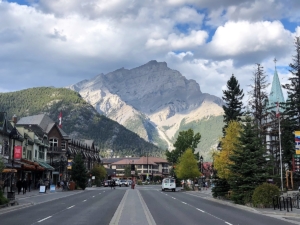
Now within Banff National Park, it is apparent the Town of Banff is tucked between Cascade Mountain to the north and Mount Rundle to the southeast.
The Three Sisters
Arguably the most picturesque of the Canmore mountains is the Three Sisters, consisting of three separate prominent peaks nestled tightly in a row.
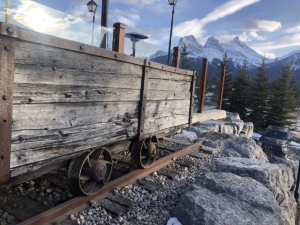
In 1883, Albert Rogers named these mountains the ‘Three Nuns’, due to the three peaks’ veiled look on their northern faces following a heavy snowfall. Individually they became known as Faith, Hope and Charity.
In 1886, George Dawson, a Canadian geologist and surveyor, modified the name to the Three Sisters. The three peaks are then known individually as Big Sister (2936 metres), Middle Sister (2769 metres) and Little Sister (2694 metres).
The traditional language of the First Nations Stoney Nakoda peoples also refers to this mountain as Three Sisters. However, the name Ĩ-ktomnĩ, (roughly pronounce ‘een-ktomneen’) refers to the old man who promises the trio of sisters in marriage.
The town of Canmore and the Three Sisters have long been associated with each other. Artists often capture these most recognizable peaks in the Bow River Valley section of Highway 1 (Trans Canada). Photographers can be seen at sunrise, when the light reveals the faces of the Three Sisters.
On a personal note, I have been admiring the Three Sisters ever since I can remember. My parents purchased a small weekend home in Canmore in the mid-1970’s. With these three magnificent mountains as backdrop, generations of family memories have accumulated.

Mount Rundle
Although the elongated side of Mount Rundle, with its many peaks can be viewed between Canmore and Banff, the most eye-catching view of Mount Rundle is in and around Banff itself. Spanning more than 12 kilometres, the original Cree name, Waskahigan Watchi means house mountain. With its distinct slope and massive size, Mount Rundle has seven distinct peaks.
In 1858, John Palliser, a British geographer and explorer, renamed the mountain after Reverend Robert Rundle. Invited to do missionary work by the Hudson’s Bay Company, Rundle carried out his work in the 1840’s in western Canada.
A classic looking, thrust faulted mountain, Mount Rundle is 2949 metres (9675 feet) in height and is the most photographed mountain in the Canadian Rockies.
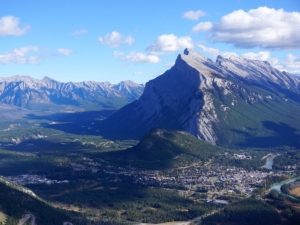
Regardless of one’s location in Banff and area, Mount Rundle makes the perfect backdrop for many photos and events. We have attended two weddings with this Mount Rundle as the backdrop, including our son and daughter-in-law’s.
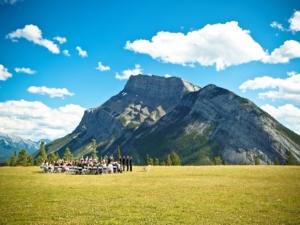
Cascade Mountain
Should a first-time visitor be driving northwest from Canmore to Banff, the gigantic face of Cascade mountain presents an illusion of a complete roadblock. Until the Trans Canada highway curves, a driver might imagine this mountain, the highest mountain near the Banff townsite, is about to bring the vehicle to an abrupt stop. It’s Cree name, Minihapa, means mountain where the water falls.
In 1858, Scottish geologist and naturalist James Hector named the mountain after the water ‘cascading’ down the south face, thus Cascade Mountain.

Cascade Mountain is an imposing looking mountain, at a height of 2998 metres (9836 feet). While driving you get so close to the base of the mountain, you may see ice climbers in the early winter before avalanche danger is prevalent.
Surprisingly, what is seen of Cascade Mountain is only the southwest end of a long, multi-peaked mountain, like the numerous peaks of Mount Rundle.
The Geological Connection of these Alberta Mountains
These beautiful mountains began forming along the same thrust fault some 75 million years ago. The Rundle Thrust Fault is relatively short, measuring 50 kilometres (30 miles) in length. It extends from just northwest of Cascade Mountain to just southeast of The Three Sisters.
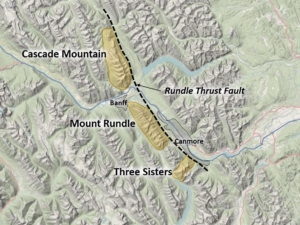
A myriad of folding, faulting, and thrusting actions occurred during an eight-million-year period of tectonic compression known as the Rundle Pulse. Rock formations deep underground were folded and thrust up and over younger rock. The Three Sisters, Mount Rundle and Castle Mountain ultimate shapes began to take emerge.
Although the macro fold-fault-thrust processes are basically the same for all three mountains, nuances in these processes and erosion gives each Rocky Mountain formation unique shapes and characteristics.
The Rundle Thrust Fault – Building the Three Sisters
In the case of the Three Sisters, the same major thrusting occurred along the entire Rundle Thrust Fault. However, further minor folding and faulting created more complicated features.
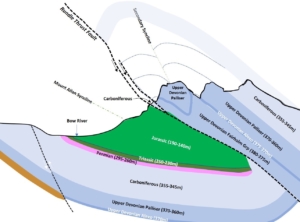
The result is only the Big Sister peak is capped with Carboniferous rocks (345 million years old). The Little and Middle Sisters are topped with slightly older Devonian aged rock formations (365 million years old), due to subsequent erosion. The lower slopes the Three Sisters, just below the Rundle Fault line, consists of significantly younger Jurassic age rock (170 million years old).
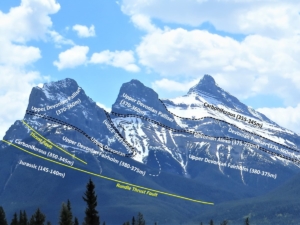
The Rundle Thrust Fault – Building Mount Rundle
The diagram below illustrates the processes involved in building Mount Rundle, one of the most famous mountains in Banff National Park. Mount Rundle’s formation began with folding of the rock layers before they fractured.

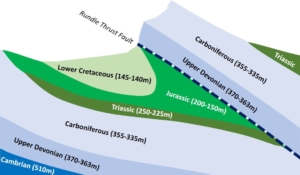
Note that although Rundle Mountain is capped with 345-million-year-old Carboniferous rock, it’s base consists of much younger Cretaceous rock (140 million years old). Oh, the power of the Rundle Thrust Fault!
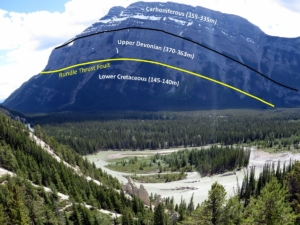
The Rundle Thrust Fault – Building Cascade Mountain
In Cascade Mountain’s case, the stratigraphy of the upper section of the mountain is the same as Mount Rundle. Yet erosion patterns result in Jurassic aged rocks (170 million years old) to form the lower slopes, like the Three Sisters. This compares to the younger Cretaceous aged rocks for Mount Rundle’s lower slopes.

All in all, a visit along the Rundle Thrust Fault rewards visitors with three magnificent Alberta mountains. As a bonus, also a fascinating geological origin.
Read More from Dave Slaght



